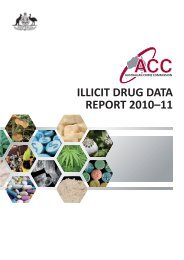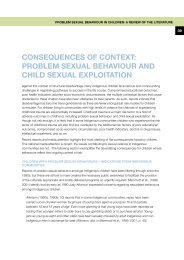Annual Report - COMPLETE - Australian Crime Commission
Annual Report - COMPLETE - Australian Crime Commission
Annual Report - COMPLETE - Australian Crime Commission
Create successful ePaper yourself
Turn your PDF publications into a flip-book with our unique Google optimized e-Paper software.
1.7 Leases<br />
A distinction is made between finance leases and operating leases. Finance leases effectively<br />
transfer from the lessor to the lessee substantially all the risks and benefits incidental to ownership<br />
of leased non-current assets. In operating leases, the lessor effectively retains substantially all<br />
such risks and benefits.<br />
Where a non-current asset is acquired by means of a finance lease, the asset is capitalised at the<br />
present value of minimum lease payments at the inception of the lease and a liability recognised for<br />
the same amount. The discount rate used is the interest rate implicit in the lease. Leased assets<br />
are amortised over the period of the lease. Lease payments are allocated between the principal<br />
component and the interest expense.<br />
Operating lease payments are expensed on a basis which is representative of the pattern of<br />
benefits derived from the leased assets. The net present value of future net outlays in respect of<br />
surplus space under non-cancellable lease agreements is expensed in the period in which the<br />
space becomes surplus.<br />
The National <strong>Crime</strong> Authority entered into leases for certain computer hardware and software<br />
during 2001-2002. These assets were transferred to the <strong>Commission</strong> at 1 January 2003. These<br />
leases are cancellable, but have been capitalised in accordance with the criteria in the accounting<br />
standard – AAS 17.<br />
Lease incentives taking the form of “free” leasehold improvements and rent holidays are recognised<br />
as liabilities. These liabilities are reduced by allocating lease payments between rental expense<br />
and reduction of the liability.<br />
1.8 Borrowing Costs<br />
All borrowing costs are expensed as incurred except to the extent that they are directly attributable<br />
to qualifying assets, in which case they are capitalised.<br />
The ACC has a number of qualifying assets for which funds have been borrowed specifically (Refer<br />
Note 6).<br />
1.9 Cash<br />
Cash means notes and coins held and any deposits held at call with a bank or financial institution.<br />
Cash is recognised at its nominal amount.<br />
1.10 Other Financial Instruments<br />
Trade Creditors<br />
Trade creditors and accruals are recognised at their nominal amounts, being the amounts at which<br />
the liabilities will be settled. Liabilities are recognised to the extent that the goods or services have<br />
been received (and irrespective of having been invoiced).<br />
Contingent Liabilities and Contingent Assets<br />
Contingent Liabilities and Assets are not recognised in the Statement of Financial Position but are<br />
discussed in the relevant schedules and notes. They may arise from the uncertainty as to the<br />
existence of a liability or asset, or represent an existing liability or asset in respect of which<br />
settlement is not probable or the amount cannot be reliably measured. Remote contingencies are<br />
part of this disclosure. Where settlement becomes probably, a liability or asset is recognised, a<br />
liability or asset is recognised when its existence is confirmed by a future event, settlement<br />
becomes probable or reliable measurement becomes possible.<br />
104 I ACC ANNUAL REPORT 2003–04




